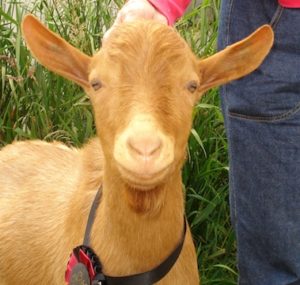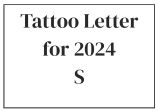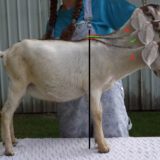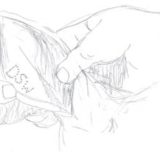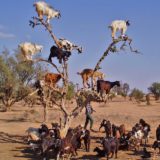Mini-Guernsey
The Guernsey dairy goat was developed using genetics from the rare Golden Guernsey Goats, an official dairy breed registered with the British Goat Society.
The Guernsey dairy goat is medium in size. The ears are erect and often set slightly lower than Swiss breeds and carried horizontally, or forward in what is termed the "bonnet" position when viewed in profile. Ear tips can be slightly upturned. The ears must not be pendulous. The nose should be either straight or dished.
The Guernsey coat/hair color should be shades of gold, ranging from very pale flaxen cream to deep russet or bronze. Full or partial roaning; white patches; white face; star/blaze are acceptable. The golden body color should be dominant, with no preference shown to any shade or pattern. Hair may be short or long and flowing or a combination of both. A long curtain, skirt, and/or dorsal fringe of body hair are desirable, although not required to meet standard.
Skin color must display a gold tone, ranging from peachy- flesh to orange-gold in one or more of these places; muzzle, ears, eyes, under tail, mammary or scrotum. Swiss facial stripes and/or rump marking; black markings or spots over 1-1/2 inches are not allowed.
PLEASE NOTE:
***BOTH Generation AND Breed Standard MUST be met to enter each herdbook***
| REQUIREMENTS | EXPERIMENTAL | AMERICAN | PUREBRED |
| Generation | F1 + | F3 + | F6 + |
| Percentage | Any | Less than 70% or more than 30% of either parent breed. | Less than 70% or more than 30% of either parent breed. |
| Breed Character | Any | Erect ears Straight or Dished nose |
Erect ears Straight or Dished nose |
| Height | Any | Max: Does 27” / Bucks 29” | Max: Does 27” / Bucks 29” |
DISQUALIFICATION FROM AMERICAN OR PUREBRED HERDBOOKS
Animals will be disqualified from American or Purebred herdbook and placed into the Experimental or American herdbook despite generation if they have any of the following:
- Animal is over 70% or under 30% of either parent breed
- Gold tone to skin
- Swiss facial stripes and/or rump marking (as on Toggenburg or Oberhasli breeds)
- Black markings or spots in hair over 1 1/2 “ in any direction
- Ears that are anything other than erect or noses that are convex
- Any animal that is overheight
**NOTE ON HEIGHTS: Currently MDGA does not require heights to be recorded with the registry except in the instance of milk testing and live shows as we know final height is not achieved until maturity (3-4 years old). It is the breeder’s responsibility to ensure their animals are within proper heights, and to submit them to the registry to have herdbooks changed when it is known they are over height.
PROGENY OF DEMOTED HERDBOOK ANIMALS
If an animal is demoted to Experimental or American due to not meeting the breed standard, they will receive an asterisk, * at the end of their registration number. If the demoted animal’s offspring meets generation AND breed standard, the offspring will then be placed in the proper herdbook. If the offspring does not meet the standard and/or generation, then they will be put into the herdbook that they meet requirements.

